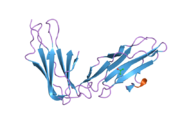Biology:LILRB2
 Generic protein structure example |
Leukocyte immunoglobulin-like receptor subfamily B member 2 is a protein that in humans is encoded by the LILRB2 gene.[1][2][3]
This gene is a member of the leukocyte immunoglobulin-like receptor (LIR) family, which is found in a gene cluster at chromosomal region 19q13.4. The encoded protein belongs to the subfamily B class of LIR receptors which contain two or four extracellular immunoglobulin domains, a transmembrane domain, and two to four cytoplasmic immunoreceptor tyrosine-based inhibitory motifs (ITIMs). The receptor is expressed on immune cells where it binds to MHC class I molecules on antigen-presenting cells and transduces a negative signal that inhibits stimulation of an immune response. It is thought to control inflammatory responses and cytotoxicity to help focus the immune response and limit autoreactivity. Multiple transcript variants encoding different isoforms have been found for this gene.[3]
LILBR2 plays a critical role in the inhibition of axonal regeneration and functional recovery after brain injury.[4] However, recent studies demonstrate that LILRB2 is a β-Amyloid receptor and may contribute to synaptic loss and cognitive impairment in Alzheimer's disease.[5][6]
Interactions
LILRB2 has been shown to interact with PTPN6.[7][8]
See also
References
- ↑ "A novel inhibitory receptor (ILT3) expressed on monocytes, macrophages, and dendritic cells involved in antigen processing". The Journal of Experimental Medicine 185 (10): 1743–1751. May 1997. doi:10.1084/jem.185.10.1743. PMID 9151699.
- ↑ "Cloning of novel immunoglobulin superfamily receptors expressed on human myeloid and lymphoid cells: structural evidence for new stimulatory and inhibitory pathways". European Journal of Immunology 27 (3): 660–665. March 1997. doi:10.1002/eji.1830270313. PMID 9079806.
- ↑ 3.0 3.1 "Entrez Gene: LILRB2 leukocyte immunoglobulin-like receptor, subfamily B (with TM and ITIM domains), member 2". https://www.ncbi.nlm.nih.gov/sites/entrez?Db=gene&Cmd=ShowDetailView&TermToSearch=10288.
- ↑ "Inhibition of PirB Activity by TAT-PEP Improves Mouse Motor Ability and Cognitive Behavior". Frontiers in Aging Neuroscience 9: 199. 2017. doi:10.3389/fnagi.2017.00199. PMID 28676756.
- ↑ "Identification of novel Aβ-LilrB2 inhibitors as potential therapeutic agents for Alzheimer's disease". Molecular and Cellular Neurosciences 114: 103630. July 2021. doi:10.1016/j.mcn.2021.103630. PMID 34029694.
- ↑ "Human LilrB2 is a β-amyloid receptor and its murine homolog PirB regulates synaptic plasticity in an Alzheimer's model". Science 341 (6152): 1399–1404. September 2013. doi:10.1126/science.1242077. PMID 24052308. Bibcode: 2013Sci...341.1399K.
- ↑ "The MHC class I binding proteins LIR-1 and LIR-2 inhibit Fc receptor-mediated signaling in monocytes". European Journal of Immunology 28 (11): 3423–3434. November 1998. doi:10.1002/(SICI)1521-4141(199811)28:11<3423::AID-IMMU3423>3.0.CO;2-2. PMID 9842885.
- ↑ "Human myelomonocytic cells express an inhibitory receptor for classical and nonclassical MHC class I molecules". Journal of Immunology 160 (7): 3096–3100. April 1998. doi:10.4049/jimmunol.160.7.3096. PMID 9531263.
Further reading
- "Central role of ILT3 in the T suppressor cell cascade". Cellular Immunology 248 (1): 59–67. July 2007. doi:10.1016/j.cellimm.2007.01.013. PMID 17923119.
- "Oligo-capping: a simple method to replace the cap structure of eukaryotic mRNAs with oligoribonucleotides". Gene 138 (1–2): 171–174. January 1994. doi:10.1016/0378-1119(94)90802-8. PMID 8125298.
- "A new human gene complex encoding the killer cell inhibitory receptors and related monocyte/macrophage receptors". Current Biology 7 (8): 615–618. August 1997. doi:10.1016/S0960-9822(06)00263-6. PMID 9259559.
- "Construction and characterization of a full length-enriched and a 5'-end-enriched cDNA library". Gene 200 (1–2): 149–156. October 1997. doi:10.1016/S0378-1119(97)00411-3. PMID 9373149.
- "A common inhibitory receptor for major histocompatibility complex class I molecules on human lymphoid and myelomonocytic cells". The Journal of Experimental Medicine 186 (11): 1809–1818. December 1997. doi:10.1084/jem.186.11.1809. PMID 9382880.
- "Human myelomonocytic cells express an inhibitory receptor for classical and nonclassical MHC class I molecules". Journal of Immunology 160 (7): 3096–3100. April 1998. doi:10.4049/jimmunol.160.7.3096. PMID 9531263.
- "A family of human lymphoid and myeloid Ig-like receptors, some of which bind to MHC class I molecules". Journal of Immunology 159 (11): 5192–5196. December 1997. doi:10.4049/jimmunol.159.11.5192. PMID 9548455.
- "The MHC class I binding proteins LIR-1 and LIR-2 inhibit Fc receptor-mediated signaling in monocytes". European Journal of Immunology 28 (11): 3423–3434. November 1998. doi:10.1002/(SICI)1521-4141(199811)28:11<3423::AID-IMMU3423>3.0.CO;2-2. PMID 9842885.
- "Tetrameric complexes of human histocompatibility leukocyte antigen (HLA)-G bind to peripheral blood myelomonocytic cells". The Journal of Experimental Medicine 189 (7): 1149–1156. April 1999. doi:10.1084/jem.189.7.1149. PMID 10190906.
- "Functional characterization of HLA-F and binding of HLA-F tetramers to ILT2 and ILT4 receptors". European Journal of Immunology 30 (12): 3552–3561. December 2000. doi:10.1002/1521-4141(200012)30:12<3552::AID-IMMU3552>3.0.CO;2-L. PMID 11169396.
- "Conserved organization of the ILT/LIR gene family within the polymorphic human leukocyte receptor complex". Immunogenetics 53 (4): 270–278. 2001. doi:10.1007/s002510100332. PMID 11491530.
- "Tolerization of dendritic cells by T(S) cells: the crucial role of inhibitory receptors ILT3 and ILT4". Nature Immunology 3 (3): 237–243. March 2002. doi:10.1038/ni760. PMID 11875462.
- "Crystal structure of LIR-2 (ILT4) at 1.8 A: differences from LIR-1 (ILT2) in regions implicated in the binding of the Human Cytomegalovirus class I MHC homolog UL18". BMC Structural Biology 2: 6. October 2002. doi:10.1186/1472-6807-2-6. PMID 12390682.
- "Human inhibitory receptors Ig-like transcript 2 (ILT2) and ILT4 compete with CD8 for MHC class I binding and bind preferentially to HLA-G". Proceedings of the National Academy of Sciences of the United States of America 100 (15): 8856–8861. July 2003. doi:10.1073/pnas.1431057100. PMID 12853576. Bibcode: 2003PNAS..100.8856S.
- "Transcriptional regulation of ILT family receptors". Journal of Immunology 171 (12): 6611–6620. December 2003. doi:10.4049/jimmunol.171.12.6611. PMID 14662864.
- "Novel single nucleotide polymorphisms in the human immune inhibitory immunoglobulin-like T cell receptor type 4". Human Immunology 65 (7): 700–705. July 2004. doi:10.1016/j.humimm.2004.04.003. PMID 15301858.
External links
- LILRB2+protein,+human at the US National Library of Medicine Medical Subject Headings (MeSH)
- LILRB2 human gene location in the UCSC Genome Browser.
- LILRB2 human gene details in the UCSC Genome Browser.
This article incorporates text from the United States National Library of Medicine, which is in the public domain.
 |



